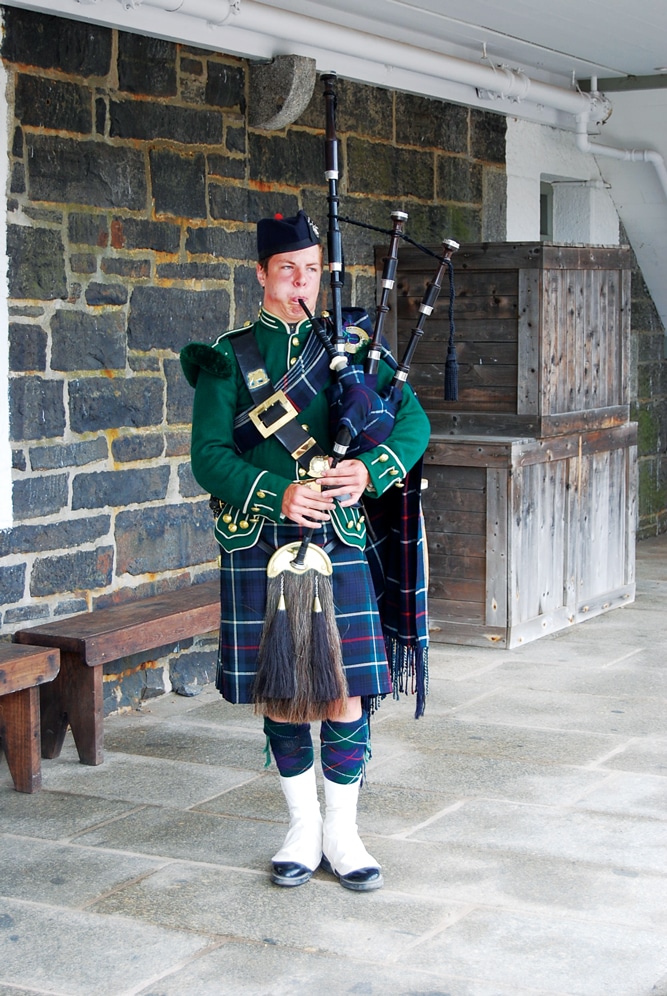A getaway to Nova Scotia’s capital reveals maritime mysteries and military majesty
Halifax, Nova Scotia, has it all: noteworthy museums, outdoor cafes and even an intriguing mystery or two. Like many RVers, we sometimes skip big cities, anticipating long commutes from distant campgrounds, heavy traffic and parking  hassles. But while traveling in our 22-foot Leisure Travel Vans Class B, we dove into Nova Scotia’s capital without breaking a sweat. Halifax is a compact waterfront city with major sights within a few square miles. Better yet, there’s a full-service municipal campground just a few minutes’ drive across a bridge into the heart of downtown.
hassles. But while traveling in our 22-foot Leisure Travel Vans Class B, we dove into Nova Scotia’s capital without breaking a sweat. Halifax is a compact waterfront city with major sights within a few square miles. Better yet, there’s a full-service municipal campground just a few minutes’ drive across a bridge into the heart of downtown.
We started our Halifax getaway by selecting a campsite with water and electricity at Shubie Park Campground in Dartmouth where young staff members gave us the Wi-Fi code and pointed out laundry and coin-operated showers. The campground operates mid-May to mid-October and has grassy sites with some pine trees for shade. Serviced sites have water and electricity and five have full hookups. Shubie Park is owned and operated by the Halifax Regional Municipality as a green space for public recreation, with two lakes and walking trails along the 19th-century Shubenacadie Canal.
The next morning, we set out to see the largest city in Atlantic Canada, which comprises the provinces of Nova Scotia, New Brunswick, Newfoundland and Labrador, and Prince Edward Island. Although campers can take Metro Transit bus service and a fast harbor ferry, we used our motorhome for transportation and drove first to a cemetery.
Haligonians (as residents are known) played a compassionate role after the RMS Titanic sank on April 15, 1912. White Star Line, Titanic’s owner, chartered four Canadian ships to recover bodies and bring them to Halifax, where 150 were buried. The nondenominational Fairview Lawn Cemetery became the final resting place for 121 victims.
Signs lead visitors to the graves where panels explain that White Star Line paid for the plot, commissioned the design and established a trust for its care. Three rows of stones curve along a slope, suggesting the shape of a ship’s bow to some who visit. The company also paid for black granite squares and the engraving of each victim’s name (if known) and identification number assigned as each one was recovered.
We quietly approached to read the inscriptions and noticed that some stones, purchased by family or friends, were larger and more elaborate. But all displayed a common date of death; authorities assumed that those who survived the sinking died very quickly of exposure in the freezing water.
During the past century, researchers have used coroner’s notes, clothing and artifacts to identify a few more victims, but many stones still are marked with only a number. The most famous is #4, known until recently as the “Unknown Child” whose body was never claimed. Sailors of the Cable Ship Mackay-Bennett, which recovered the fair-haired toddler, paid for his distinctive marker.
However, in 2007, a 95-year mystery was solved when Canadian forensic scientists examined DNA and determined that the child was 19-month-old Sidney Leslie Goodwin, youngest of a family of eight that perished in the disaster. Touched by the story, some visitors leave teddy bears, toys and coins at the base of the stone where a panel now carries his name.
Eighteen other Titanic sites are found throughout metro Halifax including the Nova Scotia Archives, which holds the original coroner’s records, and the Bedford Institute of Oceanography, whose scientists have carried out research since the wreck was located in 1985.
Our next stop, less than 3 miles away on a hilltop overlooking the city, was Halifax Citadel National Historic Site where an unsmiling, armed soldier wearing a MacKenzie tartan kilt greeted us at the front gate. This was our first encounter with dozens of historical re-enactors who portray the daily lives of troops of the 78th Highlanders and 3rd Brigade Royal Artillery assigned here in 1869.

South of Halifax, visitors to Peggy’s Cove find one of Canada’s most-photographed and visited lighthouses.
At the Information Center, we watched a 15-minute movie, “A Harbour Worth Defending,” and joined a tour for a dose of Halifax history. Our costumed guide explained that the star-shaped masonry Citadel is the fourth fort here since 1749; not one of the four ever saw battle. Planned in the 1820s to defend against potential invasion by the United States, this final version took 28 years to complete and soon became obsolete as military weapons and tactics changed.
For 45 minutes, we walked with the guide through the fort’s nooks and crannies, into dank and dark tunnels where soldiers could fire weapons while under cover. We saw where they ate, slept and kept their gunpowder, and met re-enactors representing wives who lived here also.
The Citadel crumbled into disrepair after it housed prisoners of war in World War I and Canadian soldiers in World War II, the guide explained. In 1951, Parks Canada took over the site and spent decades restoring the site to its present Victorian-era grandeur.
Our tour concluded at the Cavalier Building’s Army Museum, one that could hold its own anywhere as a stand-alone attraction. We browsed through four centuries of military artifacts including armaments, uniforms, flags and patches. The spoils of war are displayed, too: crystal wine decanters and silver candlesticks, “said to have been ‘liberated’ from the Presidential Mansion” during the August 1814 British raid on Washington, D.C.
Ascending the ramparts, we witnessed a 150-year Halifax tradition: the firing of the noon gun. A crowd gathered to watch Royal Artillery re-enactors position, load and fire a reproduction 12-pound, muzzle-loading gun. Our three hours at Halifax Citadel ended as the 78th Highlanders’ nine-bagpipe band, complete with four drummers, came marching into the courtyard playing their instruments.
Street parking downtown is scarce, but we grabbed a space just in time for a late lunch on Granville Street at one of many pubs with sidewalk cafes that attract office workers and students from the area’s five universities. To accompany hearty bowls of seafood chowder, we ordered cold mugs of Keith’s India Pale Ale, a product of Alexander Keith’s Brewery, founded in Halifax in 1820 and available for touring.
Two blocks down the steep hill, we strolled a waterfront boardwalk lined with restored warehouses and entered the Maritime Museum of the Atlantic, Canada’s oldest and largest, to view a collection of marine artifacts.
Best-known is an assortment of wooden pieces that Halifax seamen on recovery ships found floating after Titanic sank. (The museum is opposed to commercial salvage on the wreck, which it considers a memorial and archaeological site.) A rare intact deck chair, a mahogany cabinet, a carved oak newel post and more are displayed, all donated by sailors’ descendants.
Museum curators now believe a tiny pair of brown leather shoes belonged to the Unknown Child, Sidney Leslie Goodwin, whose grave we had visited that morning. The shoes were saved by a policeman who didn’t have the heart to burn the toddler’s shoes in 1912 along with other victims’ clothing, and instead put them in a desk drawer hoping relatives might claim them someday.
The museum also tells the heart-wrenching Halifax story of the largest man-made explosion prior to the atomic bomb, caused by a disastrous 1917 collision of two ships in the harbor. One was filled with explosives, which leveled parts of the city, killed approximately 2,000 people and injured 9,000 more.
Help came from all over North America after the explosion, especially from the city of Boston, Mass., which still receives a huge Nova Scotia Christmas tree each year as a gift honoring the bond created between the cities. In April 2013, Haligonians raised money for victims of the Boston Marathon bombing and held a foot race to show support.
The second day of our Halifax getaway dawned clear and sunny for a drive south along a rocky coast of scenic bays studded with tiny islands and fishing villages. Just 30 miles south of the city is Peggy’s Cove, famous for its red-topped white lighthouse, the most-visited and photographed in Nova Scotia.
We ventured farther south to the shipbuilding and fishing town of Lunenburg, founded in 1753 on a hill that slopes to a pretty harbor. An assortment of British, French, Swiss and German settlers built homes here in an array of styles, and many houses sport colorful paint jobs and the “Lunenburg bump,” a large dormer popular in the late 19th century. But along with its scenic charm, Lunenburg has marine industries that are just as important to the economy as tourism.
We walked to the bright-red Fisheries Museum of the Atlantic that makes it fun for visitors to soak up the history of 500 years of Banks fishing off Canada’s east coast. Retired fishermen answer questions and share their stories to complement exhibits about boats, engines, whales and much more. Ship models are on display and skilled local builders create dories in the working boat shop.
At the museum, we learned that Lunenburg is the home port for Bluenose II, a replica of a historic Grand Banks racing schooner. Now a tall-ship ambassador and symbol of the province, the sleek vessel has been in a shed undergoing restoration but will soon be back on the high seas.
Before returning to the city, we couldn’t resist a peek at the site of another mystery. Oak Island in Mahone Bay has been notorious since 1795 for its mysterious Money Pit, the stuff of which dreams, novels and reality TV shows are made. Men have lost their lives excavating shafts (which invariably flood) in repeated, futile efforts to reach a legendary treasure. Pirate gold? Royal jewels? No one knows for sure.
We drove up to a narrow causeway blocked by a gate with a sign warning off casual visitors, and peered past at the private island. All was still, except for a light breeze moving through the spruce trees, and the Money Pit was hidden from our view.
We drove on, plenty content with all that we had mined during our summer trip: new RV travel memories to treasure forever.
For More Information

Visitors cover their ears for the firing of the Halifax Citadel Noon Gun, a tradition for 150 years.
Destination Halifax
877-422-9334
www.destinationhalifax.com
Halifax Citadel National Historic Site
www.pc.gc.ca/lhn-nhs/ns/halifax/visit.aspx
Lunenburg
www.explorelunenburg.ca
Maritime Museum of the Atlantic
http://maritimemuseum.novascotia.ca
Shubie Park Campground
800-440-8450
www.shubiecampground.com
Titanic in Nova Scotia
www.titanic.gov.ns.ca
 Christine Goodier is a freelance writer and editor who lives on the North Carolina coast and travels with her husband, photographer Bob Goodier, in a Class B Sprinter motorhome.
Christine Goodier is a freelance writer and editor who lives on the North Carolina coast and travels with her husband, photographer Bob Goodier, in a Class B Sprinter motorhome.







